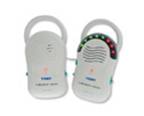E. Finding whether the baby or an ill person is calling out
1. You can use a baby or invalid alarm with flashing light unit.
2. You can use a baby or invalid alarm that has a vibrating unit.
3. You can wear the hearing aid when perhaps you might have taken it off when alone in the house.
4. The hearing person in the house could let you know that help is needed. (Perhaps the hearing person could give the help if it’s feeding the baby in the middle of the night!)
5. You may want to use an intercom system. Intercom systems are available with wires or without.
Without wires:
A sound monitor: The transmitter plugs into a socket in the baby’s room near to the baby. The receiver is plugged in near to the hard of hearing person. As this method relies on being able to hear sound through the monitor this option may only suit people with a mild hearing loss.
 Baby alarms: Some baby alarms on the general market have visual indicators which show the level of sound even though they are not designed specifically with hearing impaired people in mind. These lights are not bright enough to wake a sleeping deaf person. Some are mains powered, some are battery powered and on some models you have a choice.
Baby alarms: Some baby alarms on the general market have visual indicators which show the level of sound even though they are not designed specifically with hearing impaired people in mind. These lights are not bright enough to wake a sleeping deaf person. Some are mains powered, some are battery powered and on some models you have a choice.
The transmitter is positioned near to the baby and the portable receiver can be moved around with the parent.
If you need to be alerted to several noises around the home – e.g. smoke alarm, baby alarm, doorbell, phone, etc, then a multi-alert system may be the best option.
If you feel you would benefit from any help about knowing when your baby or someone who is ill is calling out, your first port of call should be your local Social Services who should be able to tell you what is available in your area. See the section above on Obtaining Environmental Aids.